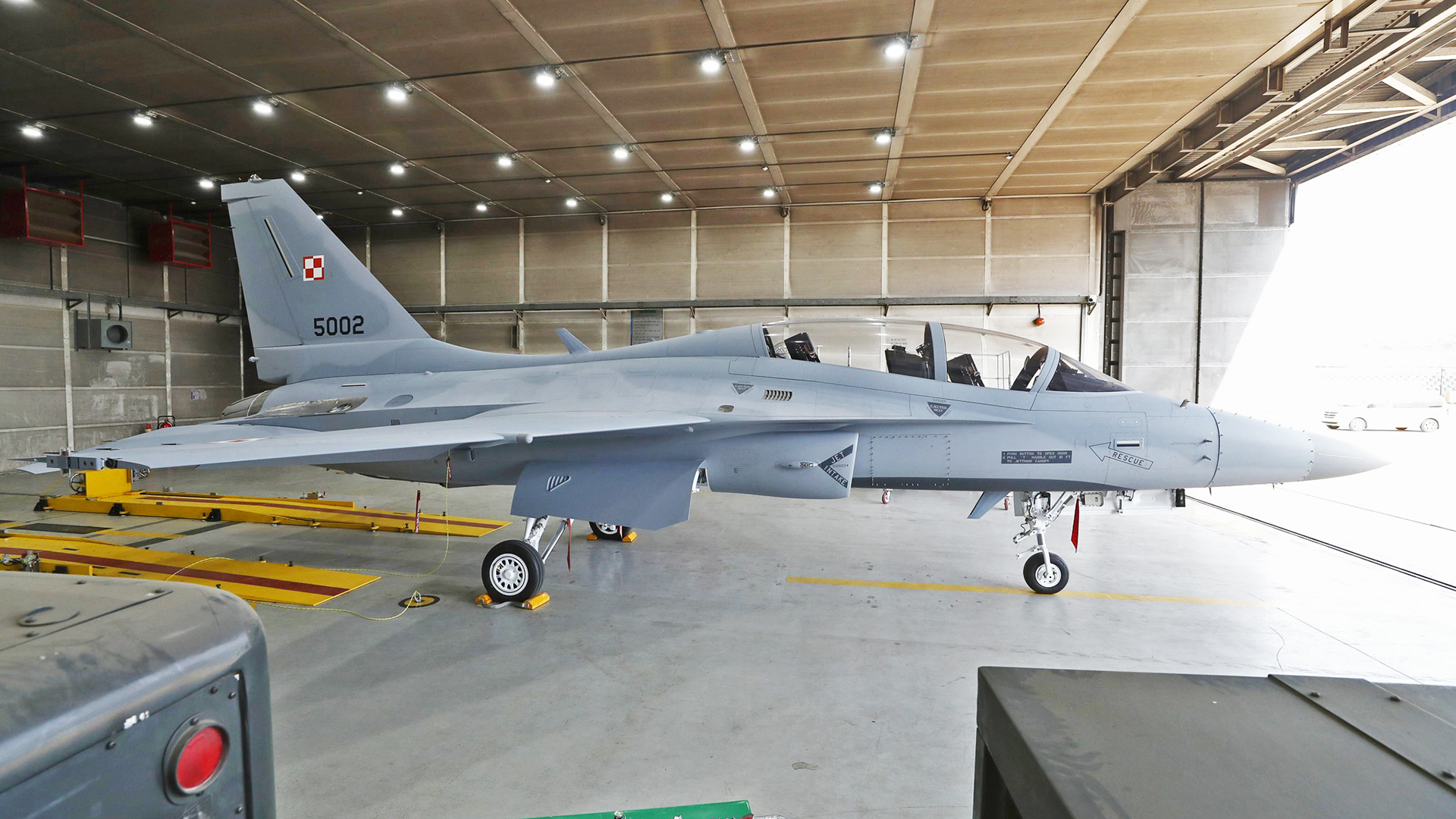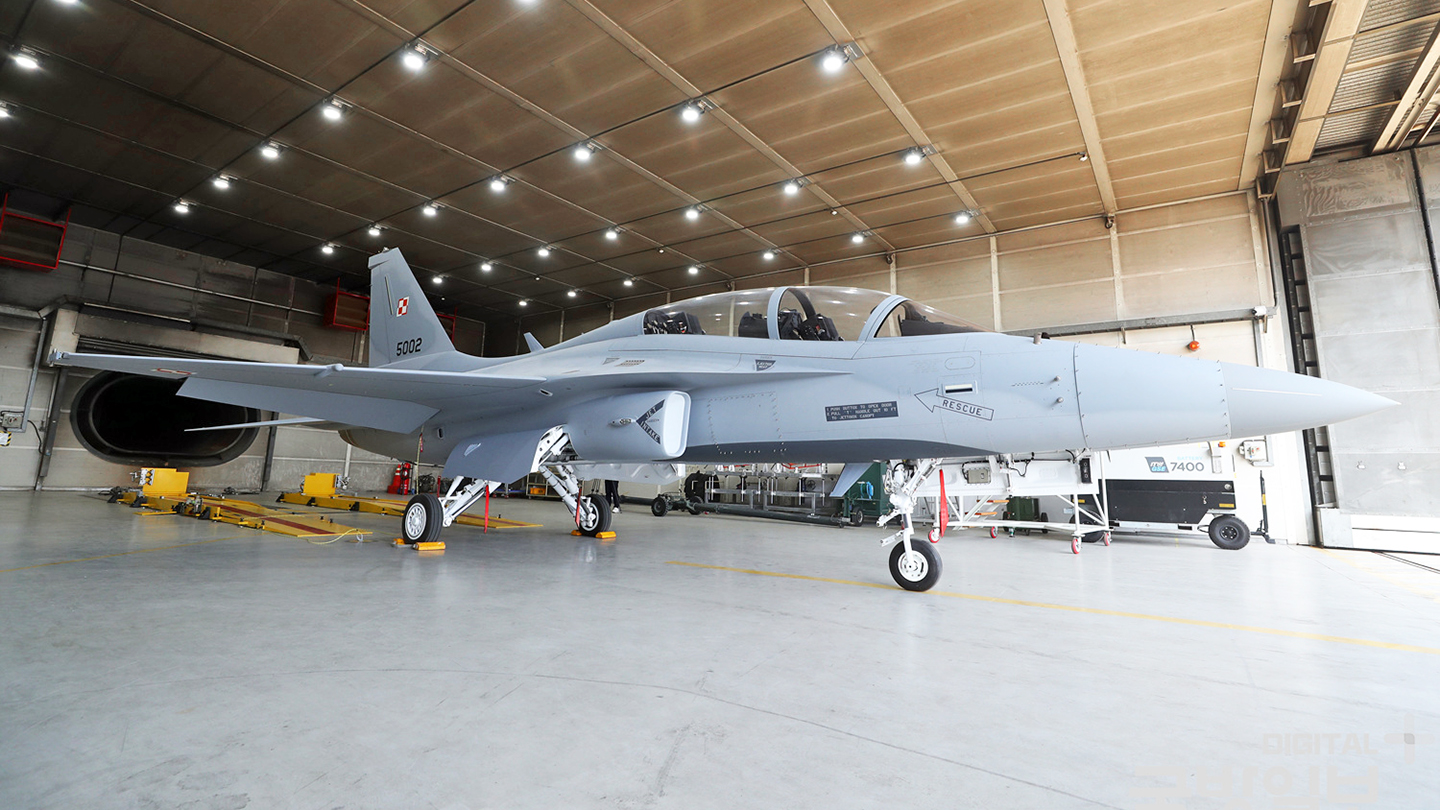Korea Aerospace Industries (KAI) has shared the first photos of what will be Poland’s new FA-50 Fighting Eagle light fighter after the European country inked the deal to acquire the aircraft last September. The FA-50s will help ease the Polish Air Force’s dependence on its aging Soviet-era fleet of Su-22 Fitter ground-attack jets and MiG-29 fighters, the latter of which Warsaw has been saying it would be willing to send to Ukraine on and off for nearly a year.
The photos of the Polish FA-50s released by KAI were taken at the company’s Sacheon facility in South Korea. In the images, it can be seen that the fighter has the service number 5002 and has been customized with the Polish Air Force’s (PAF) standard grey camouflage and tell-tale white and red checkered insignia. A ‘false canopy’ is also seen painted onto the underside of the FA-50’s fuselage to confuse enemy aircraft in the heat of close-range combat, as well. According to Flightglobal, this is the first time such a feature has been used on a PAF jet.

The agreement reached between Poland and KAI last September to provide the PAF with FA-50s was just one part of what proved to be the biggest arms export deal ever for the Republic of Korea (ROK). Along with what will eventually be a fleet of 48 FA-50s, the ROK has also sold Poland 180 K2 Black Panther tanks and approximately 670 K9 Thunder self-propelled artillery units comprising a deal worth upwards of $14.5 billion.
“When ordering modern weapons for the Polish Army, we follow four criteria: The first criterion is the needs, the second modernity, the third speed of delivery, and the fourth criterion is compatibility,” Poland’s Defense Minister Mariusz Błaszczak has said. “All these criteria are met in the framework agreement of cooperation signed with South Korea.”

The 48 FA-50s the PAF is slated to receive will be split up into two variants. Twelve aircraft will be designated as FA-50GF, or Gap Filler, which are modified TA-50 Block II Golden Eagle training aircraft originally meant for the ROK Air Force (ROKAF). FA-50GF is the variant pictured in the images shared by KAI. The company will begin delivering the first of the 12 FA-50GF variants to the PAF beginning this August with the rest expected to be handed over at the end of the year.

The second variant, designated as FA-50PL, is a new-production aircraft built specifically for the PAF, and the service will be receiving 36 of this type under the agreement with KAI. The company is aiming to deliver the first FA-50PL aircraft in the fall of 2025, with the rest of the shipment projected to reach Poland sometime in late 2028. The overall delivery will also come with spare parts, technical support, logistics packages, and flight simulators.
PAF pilots began training on the KAI FA-50 in South Korea in late February of this year, five months after the arms export deal was reached. According to Janes, local media in Seoul reported on Feb. 22 that the first four PAF pilots had been inducted into the ROKAF’s 1st Fighter Wing at Gwangju and will complete a 23-week training program that includes computer-based training as well as flights in the TA-50 trainer before the end of July.
FlightGlobal reported that an additional four pilots, including the PAF’s first female FA-50 aviator, will comprise a second wave of students that will travel to South Korea to start training in April. The outlet said that this group is expected to return to Poland later this fall and that the ROK will provide training for PAF technicians, as well.
The KAI FA-50, a two-seat, single-engine light fighter/advanced trainer, is based on the ROKAF’s T-50 Golden Eagle training jet that Poland will be receiving the modified variants of. An armed and radar-equipped TA-50 variant also exists with the ROKAF. The PAF’s FA-50GFs will largely remain in the same configuration as the T-50 but with improved avionics, additional internal fuel capacity, and a radar warning receiver suite.
The FA-50PLs will ultimately receive tactical data links, Sniper advanced targeting pods, active electronically scanned array (AESA) radars, advanced self-protection capabilities, more fuel capacity, and the ability to launch precision-guided munitions like the AGM-65 Maverick air-to-ground missile and GBU-38/B Joint Direct Attack Munitions (JDAM).

Other weapons that the Polish Ministry of Defense hopes to integrate into the FA-50 platform include Raytheon’s AIM-120 advanced medium-range air-to-air missile. However, Brig. Gen. Ireneusz Nowak, deputy of the Inspector of the PAF, said in an interview that the addition of this capability will occur at the end of the service’s FA-50 aircraft development roadmap as it’s dependent on the integration of the AESA radar.
In the same interview, Nowak also said that the first batch of FA-50GFs will be able to carry AIM-9 L/M Sidewinder missiles for “air policing missions.” He went on to note that the follow-on FA-50PL variants will also be capable of employing AIM-9X missiles that will be integrated with a Joint Helmet Mounted Cueing System. There has even been talk of Poland being interested in the South Korean-developed KGGB glide bomb for the FA-50PLs, a GPS-guided weapon that could provide the aircraft with another all-weather precision standoff strike capability.

The FA-50s take after the inspiration its progenitor, the T-50, pulled from the American-made F-16 Viper. The basic aircraft’s design and pilot interfaces were heavily influenced by the F-16, with Lockheed Martin working directly with KAI on its development. The T-50/FA-50 family is now flying or has been selected to fly for the air arms of South Korea, Iraq, Indonesia, Philippines, Thailand, and Malaysia, in addition to the Polish Air Force.
As The War Zone has reported in the past, test pilots of T-50/TA-50/FA-50 types have even said that these aircraft have, at least under some conditions, better turning performance than the F-16 thanks to the design of its airframe, high thrust-to-weight ratio, and digital flight control computer. Powered by the General Electric F404 engine’s 17,700 pounds of thrust, the FA-50 can also fly at a maximum speed of Mach 1.5, rounding out its fighter-like qualities.

The PAF’s first tranche of FA-50s will head directly to the country’s 23rd Tactical Air Base (TAB) located just east of Minsk Mazowiecki city. A full mission simulator as well as associated infrastructure like new hangars to support the fleet will be constructed at the base as well.
Interestingly, this location is where the PAF’s existing fleet of the MiG-29s it has frequently considered sending to Ukraine are housed, making the overall timing of the FA-50 delivery at the very least notable. The MiG-29s from Minsk Mazowiecki with the lowest number of operational cycles have since been transferred to the 22nd TAB in the city of Malbork where another squadron equipped with MiG-29s is based. It is unclear, however, where the rest of the FA-50GFs and FA-50PLs will be stationed, but Breaking Defense last September reported that Malbork is believed to be one possibility.

However, it’s important to highlight that FA-50s are not really a direct replacement for MiG-29s but more so for the Su-22s. In fact, before Poland ultimately decided to go with KAI’s FA-50 offer, it was highly believed that the country would go with a light combat aircraft version of Leonardo’s M-346 trainer jet, which Poland already flies. The performance on the FA-50 is certainly higher and its commonality with the F-16 makes it very easy to convert pilots to and from the type. The F-16’s infrastructure in Poland can also be leveraged in many cases for the FA-50.

All told, Poland seems hopeful about its new light fighters. In the interview cited earlier, Nowak explained how the PAF’s new FA-50s will be “network-centric” and “fully ready to cooperate with the F-16 and F-35” aircraft that the country already flies. In addition to these combat flights in “Mixed Fighter Force Operations,” Nowak goes on to say that the FA-50s will be able to perform close air support, strike coordination, reconnaissance, and air interdiction missions.
The general timing of KAI’s sharing of the PAF FA-50 images and the steady progression of the service’s pilot training in South Korea would suggest that aircraft deliveries could go as intended. If that proves to be the case, then Poland should be ridding itself of at least a significant portion of what’s left of its dated Soviet fighter fleet in the not-so-distant future.
Contact the author: Emma@thewarzone.com
